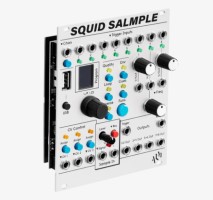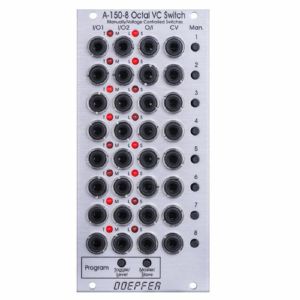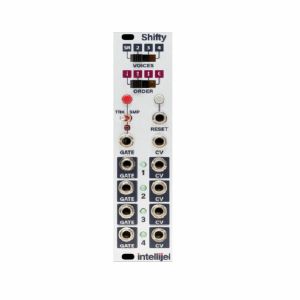Synth modules
The Eurorack modular synth format is one of the most exciting areas of music technology. Pioneered by Doepfer, there are now hundreds of brands offering compatible modules of all varieties. You can combine your choice of the best oscillators, filters and much more in order to create a unique, bespoke synth setup which perfectly suits your needs.
Eurorack modules offer the biggest range of options you can imagine, from basic analogue modules which replicate the sound of classic vintage synths, through to digital modules which allow you to explore completely new approaches to making music.
Whether you’re a beginner or a more experienced modular head, you can take your pick of the best modules from leading brands including Mutable Instruments and ALM Busy Circuits.
Our range also includes accessories, cases, patch cables and much more, allowing you to build and customise your perfect modular synth setup.

Artikel 1 bis 3 von 3 auf Seite 1 von 1 anzeigen
Cat: 671556 Rel: 29 Nov 17
Manually or voltage controlled switch module - 12HP
Notes: Module A-150-8 contains eight manually/voltage controlled switches. Each of the eight switches has a manual control button (Man.), a control voltage input (CV), a common Out / Input (O/I), and two In / Outputs (I/O1, I/O2). The switches are bi-directional, i.e. they can work in both directions, so can connect one input to either of two outputs, or either of two inputs to one output. Two LEDs show which in / output is active (i.e. which is connected to the common out / input). In addition, the LEDs are used for the programming of the module:
For each unit the operating mode can be selected: Toggle or Level controlled. In Toggle mode the rising edge of the CV input or operating the manual control button changes the state of the switch. In Level mode the switch state is defined by the voltage applied to the CV input (low voltage = I/O1, high voltage = I/O2) or by the state of the manual control button (not pressed = I/O1, pressed = I/O2). The modes are programmed very easily: Operating the Toggle/Level button of the program section displays the current state of each switch with the LEDs: left LED on = Toggle mode, right LED on = Level mode. Operating the manual control button of the switch in question changes the toggle/level mode while the Toggle/Level button of the program section is operated. During the programming patched CV signals may have to be removed as the CV signals would interfere with the manual operating buttons during the programming process.
In addition, it's possible to define master/slave groups. In such a group the upper unit (= master) controls also the state of the following switches provided that they are defined as slaves. Master/slave programming is also very simple: Operating the Master/Slave button of the program section displays the current state of each switch with the LEDs: left LED on = Master, right LED on = Slave.
When all 8 units are defined as master all switches are independent from each other. If for example the sequence is MSSSMSMS the control unit of the first switch also controls the switches 2, 3 and 4. The control unit of switch 5 also controls the switch 6, and the control unit of switch 7 also controls the switch 8. The current states of the slave switches are overwritten by the state of the master switch.
Technical note: To protect the electronic switches in case of an unsuitable patch (e.g. connection of two outputs) a 1k protection resistor is inserted into the O/I line of each switch. If control voltages used for VCOs are switched this may cause a small voltage drop and lead to undesired audible detuning. For this application we recommend to insert a CV buffer between A-150-8 and the VCO(s), e.g. the Buffered Multiple A-180-3 or the Precision Adder A-185-2. Integrating the buffers into the module A-150-8 was not possible because this would ruin the bidirectionality of the switches.
Width: 12 HP / 60.6 mm
Depth: 55 mm (measured from the rear side of the front panel)
Current: +40mA (+12V) / -5mA (-12V)
… Read moreFor each unit the operating mode can be selected: Toggle or Level controlled. In Toggle mode the rising edge of the CV input or operating the manual control button changes the state of the switch. In Level mode the switch state is defined by the voltage applied to the CV input (low voltage = I/O1, high voltage = I/O2) or by the state of the manual control button (not pressed = I/O1, pressed = I/O2). The modes are programmed very easily: Operating the Toggle/Level button of the program section displays the current state of each switch with the LEDs: left LED on = Toggle mode, right LED on = Level mode. Operating the manual control button of the switch in question changes the toggle/level mode while the Toggle/Level button of the program section is operated. During the programming patched CV signals may have to be removed as the CV signals would interfere with the manual operating buttons during the programming process.
In addition, it's possible to define master/slave groups. In such a group the upper unit (= master) controls also the state of the following switches provided that they are defined as slaves. Master/slave programming is also very simple: Operating the Master/Slave button of the program section displays the current state of each switch with the LEDs: left LED on = Master, right LED on = Slave.
When all 8 units are defined as master all switches are independent from each other. If for example the sequence is MSSSMSMS the control unit of the first switch also controls the switches 2, 3 and 4. The control unit of switch 5 also controls the switch 6, and the control unit of switch 7 also controls the switch 8. The current states of the slave switches are overwritten by the state of the master switch.
Technical note: To protect the electronic switches in case of an unsuitable patch (e.g. connection of two outputs) a 1k protection resistor is inserted into the O/I line of each switch. If control voltages used for VCOs are switched this may cause a small voltage drop and lead to undesired audible detuning. For this application we recommend to insert a CV buffer between A-150-8 and the VCO(s), e.g. the Buffered Multiple A-180-3 or the Precision Adder A-185-2. Integrating the buffers into the module A-150-8 was not possible because this would ruin the bidirectionality of the switches.
Width: 12 HP / 60.6 mm
Depth: 55 mm (measured from the rear side of the front panel)
Current: +40mA (+12V) / -5mA (-12V)
1 in stock $174.03
Intellijel Shifty Voice Allocator/Note Hocketing/Analogue Shift Register Module (sample & hold/sequencer/shift register synth module)
Cat: 643384 Rel: 27 Mar 17
Voice allocator, note hocketing & analog shift register module - 6HP
Notes: The Shifty is essentially a combination of four sample and hold stages, a sequential gate and sequencer controller. This collection of functions allows for some specific and useful utility application.
One of the primary uses for Shifty is to take a monophonic sequence source and route each new note of the sequence to up to four different synthesizer voices in a specific pattern. In this way you can create pseudo polyphonic sequences since each voice can be triggered to play and sustain while the next voice int the sequence gets triggered. Another term for this is hocketing.
The other main application of the Shifty is to function as an Analog Shift Register. In this mode each new gate input received causes the current set of pitches to be shifted to new output locations as a new one is added and the oldest one is replaced. This can be an interesting way to create chords that are up to four stacked notes when used with a pitch sequence source that has a harmonious series of notes (e.g. a pentatonic scale works really well). Even just using two of the outputs will yield very interesting melodic interplay and is an excellent way to make a simple sequence much more complex and interesting.
In a more basic way the Shifty could be used as a simple Sample/Track and Hold module or as a sequential gate.
… Read moreOne of the primary uses for Shifty is to take a monophonic sequence source and route each new note of the sequence to up to four different synthesizer voices in a specific pattern. In this way you can create pseudo polyphonic sequences since each voice can be triggered to play and sustain while the next voice int the sequence gets triggered. Another term for this is hocketing.
The other main application of the Shifty is to function as an Analog Shift Register. In this mode each new gate input received causes the current set of pitches to be shifted to new output locations as a new one is added and the oldest one is replaced. This can be an interesting way to create chords that are up to four stacked notes when used with a pitch sequence source that has a harmonious series of notes (e.g. a pentatonic scale works really well). Even just using two of the outputs will yield very interesting melodic interplay and is an excellent way to make a simple sequence much more complex and interesting.
In a more basic way the Shifty could be used as a simple Sample/Track and Hold module or as a sequential gate.
1 in stock $187.11
Klavis Mixwitch Mixer & CV/Clock-Controlled Switcher Module (black) (attenuator/mixer/polarizer/switch synth module)
Cat: 951655 Rel: 20 Jun 24
Mixer and CV/clock-controlled switcher module - 8HP.
Notes: Mixer & CV/clock-controlled Switcher
Focused versatility seems an oxymoron when describing the features that led to the design of the Mixwitch.
With only a pinch of mixing, inverting and controlled switching, Klavis Electronics brew up a plethora of combinations and uses.
This is voltage processing magic!
The Mixwitch design comes from a frustration with attenuvertors (bipolar attenuators-inverters) whose off (neutral) position is difficult to retrieve, especially in live situations.
Klavis went for a digitally-controlled analogue path where polarity inversion would be at the touch of a button. So, the usefulness of attenuating/inverting can be realized by turning the pot down, swiftly pressing the inversion button and reopening the level. The zero level is where you expect it, with the pot full down.
Once a clean polarity control was established, a mute function was added, offering the benefit of pre-adjusted pot settings ready to be activated at will.
The next step was to bring something extra, useful and creative. There are plenty of analogue switches controlled by a clock; but arbitrarily selecting an input with a voltage is less known. Having both control capabilities combined with Klavis' specific mixer features creates a unique fusion: welcome to the Mixwitch!
Dimensions
8 HP
25 mm deep
Current Draw
39 mA +12V
24 mA -12V
0 mA 5V
… Read moreFocused versatility seems an oxymoron when describing the features that led to the design of the Mixwitch.
With only a pinch of mixing, inverting and controlled switching, Klavis Electronics brew up a plethora of combinations and uses.
This is voltage processing magic!
The Mixwitch design comes from a frustration with attenuvertors (bipolar attenuators-inverters) whose off (neutral) position is difficult to retrieve, especially in live situations.
Klavis went for a digitally-controlled analogue path where polarity inversion would be at the touch of a button. So, the usefulness of attenuating/inverting can be realized by turning the pot down, swiftly pressing the inversion button and reopening the level. The zero level is where you expect it, with the pot full down.
Once a clean polarity control was established, a mute function was added, offering the benefit of pre-adjusted pot settings ready to be activated at will.
The next step was to bring something extra, useful and creative. There are plenty of analogue switches controlled by a clock; but arbitrarily selecting an input with a voltage is less known. Having both control capabilities combined with Klavis' specific mixer features creates a unique fusion: welcome to the Mixwitch!
Dimensions
8 HP
25 mm deep
Current Draw
39 mA +12V
24 mA -12V
0 mA 5V
1 in stock $150.14
Click for better price!
or call +44 20 7424 1960
quote 951655
quote 951655
Artikel 1 bis 3 von 3 auf Seite 1 von 1 anzeigen

 USD
USD







